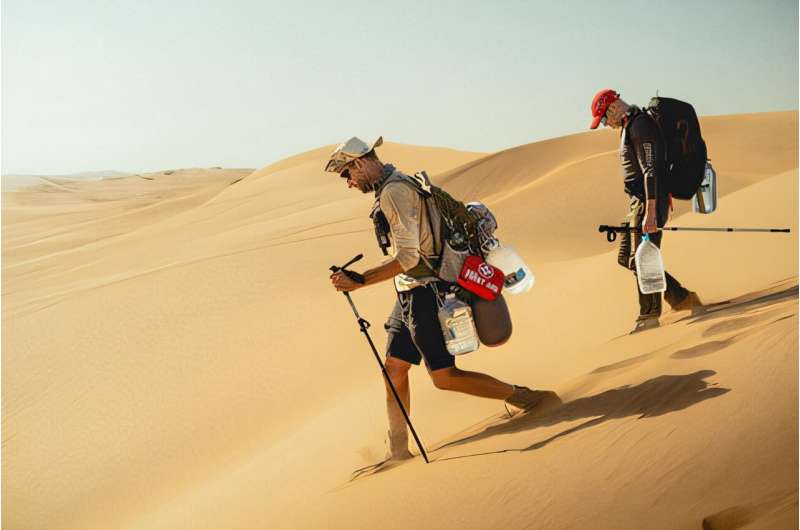

Strewn across the Namib desert is a treasure trove of stone tools of which little is known because getting to them is so difficult. There are few roads and vehicles have limited access in this protected area that lies in the desert of western Namibia.
So when two researchers, Professor Dominic Stratford and Dr. George Leader, decided to explore possible archaeological sites in what is considered to be one of the driest, most inhospitable deserts in the world, they had no option but to traverse the landscape on foot.
The two academics are associated with the University of the Witwatersrand and College of New Jersey, U.S. and have had a long association with Namibia.
The plan was to follow the course of the ancient Tsondab River that flowed from the central escarpment west towards the sea, an area that is now the Namib Naukluft National Park. By following the river, the two archaeologists hoped to find evidence of human and hominin use of this ancient landscape.
Ahead of them would be a trek of over 160 kilometers through a landscape of gravel plains and sand dunes, some of which tower over 100 meters above the interdune flats.
Namibia is still a relatively unknown territory to both archaeology and paleoanthropology as little of the country has been explored in detail by scientists. As yet no early hominin fossils have been found in Namibia, although Stratford believes they are there and are waiting to be found.
During the 1980s, anthropologist Myra Shackley traveled across southern Namibia documenting numerous isolated sites, including a few sites deep in the Namib Sand Sea, where she discovered handaxes attributed to the Earlier Stone Age and areas rich in Middle Stone Age tools.
Over the last four years, a small team of interdisciplinary paleoscientists led by Leader have been working on two of those sites to better understand their age and how the hominins that made the stone tools survived in the desert.
It was Shackley’s early discoveries and the data recovered during the new research project that motivated Leader and Stratford to head out on their trek in June.
“We decided, the best thing to do to really understand the distribution of sites across the landscape would be to get a good transect across the desert,” Stratford explains.
But getting there would require a hard slog with the pair carrying everything they would need for their expedition.
They began their journey just north of Solitaire, a small town close to the eastern edge of the Namib-Naukluft National Park.
The plan was to be resupplied three times by vehicle as they plotted their journey towards the sea. Besides lugging everything on their backs, they also pulled along a cart that carried the bulk of their water and food.
They discovered it was going to be tougher than they had initially planned. Heading up those story-high dunes pulling a cart was torture.
“It was horrible, we budgeted for about one mile an hour, and that first day we hit the dunes, we did one mile in five hours,” says Stratford.
They soon learned how to identify more compact sand on the dunes that allowed them to climb faster.
The two walked 10 hours a day for 12 days across the enormous desert landscape, where temperatures would rise to 38 degrees Celsius, then fall to a chilly 5 degrees at night. In that time, they endured a two-day-long sandstorm and when they got closer to the coast, heavy fog and fine, cold rain that soaked everything and made choosing the right path across dunes very difficult.
Stratford almost didn’t make the trip. Just three weeks before heading to Namibia, he discovered that he had to have his appendix removed.
“I said to the doctor, “I am supposed to be in Namibia in three weeks, walking across a desert,” to which the doctor replied, “Well, we’ll see how your healing goes,” and then said “You are not supposed to lift anything for six weeks after the operation.” So, it was a pretty tense time and I definitely didn’t want to let my teammate down.”

Fortunately, Stratford was healed enough to walk when they headed out.
If anything had gone wrong, they had satellite trackers monitoring their movements and a helicopter in Walvis Bay was available if there was need of an serious emergency evacuation.
As they walked the length of the river, they took sediment samples, which they hope will tell them how long ago the river flowed and how strong that river was.
So little is known about this river that its course and length are not at all clear. It is the tiny patches of river deposit and ancient ephemeral pans found between the dunes that tells the story of the river’s course, and of people’s presence in the desert.
What the pair did find were amazingly well-preserved stone tools.
“There were artifacts everywhere, and some of them were quite stunning,” says Stratford.
Some of these tools might be 1.4 million years old, made at a time long before the arrival of modern humans. The more recent tools, however, may date back to between 200 and about 30 thousand years.
But in the past the landscape through which Stratford and Leader walked was at times very different to the hyper-arid desert seen today.
Fossils recovered in the area have revealed that animals such as elephants and antelopes once lived on the edge of the Tsondab river and the pans it filled at times when the river won its battle against the encroaching dunes.
“People have claimed that the Namib Desert is the oldest desert and it’s been like this for many millions of years. In reality, it has changed a lot through its history, with pulses of wetter periods punctuating a landscape becoming increasingly arid,” says Stratford.
Their journey across the Namib ended with a dash to the coast. The plan was for a third supply drop 26 km from the coast (budgeted as a two day walk across the soft coastal dunes) but this had to be canceled when it became clear the support vehicle wouldn’t be able to cross the high dunes further north to get near them.
Stratford and Leader were given a choice.
“Either we turn around and meet them somewhere, giving up on the last leg, or we push and we try and do it all in a day with the supplies we had left,” says Stratford.
They decided to press on. That day would consist of covering 16 miles (almost 26km) over massive coastal dunes, with loose sand.
They had to make the pick-up point on the coast at 9 am the following morning at low tide—the only time a vehicle sent from Walvis Bay could reach them. If they missed the deadline, they would have to wait another 24 hours before they could be picked up, and they would run out of food and water. “We made it onto the beach with 15 minutes to spare,” says Stratford.
During the course of their expedition, they discovered over 40 new archaeological sites that stretched almost the entire length of the transect, from east to west, and they came home with a whole lot of unanswered questions about the ancient river and the people that seemingly also explored that landscape many thousands of years ago.
One of them is why humans and earlier hominins ventured into areas that were so challenging most of the time while places with abundant water and rich flora and fauna were not that far away (200kms).
In the future, Stratford and Leader want to head back to Namibia to perhaps do another exploratory overland trek to explore some of the huge pans that they only quickly sampled on their walk. They also need to find a way to excavate the isolated archaeological sites they discovered.
But while walking across this hostile environment, Stratford came to see those ancestors, he is trying to understand, in a different light.
“It’s very easy to drive out to an archaeological site, and not really get a sense of what it takes to be there. But when you’ve walked in and you’re sitting there surrounded by dunes, and you sleep there, and you get smashed by a sandstorm or two, then you start to ask some questions about why you made those choices, and also why those hominins that were there thousands of years ago would also be making those choices.”
Provided by
Wits University
Citation:
In search of evidence of ancient human existence, researchers traverse the inhospitable Namib desert (2024, October 17)
retrieved 17 October 2024
from https://phys.org/news/2024-10-evidence-ancient-human-traverse-inhospitable.html
This document is subject to copyright. Apart from any fair dealing for the purpose of private study or research, no
part may be reproduced without the written permission. The content is provided for information purposes only.